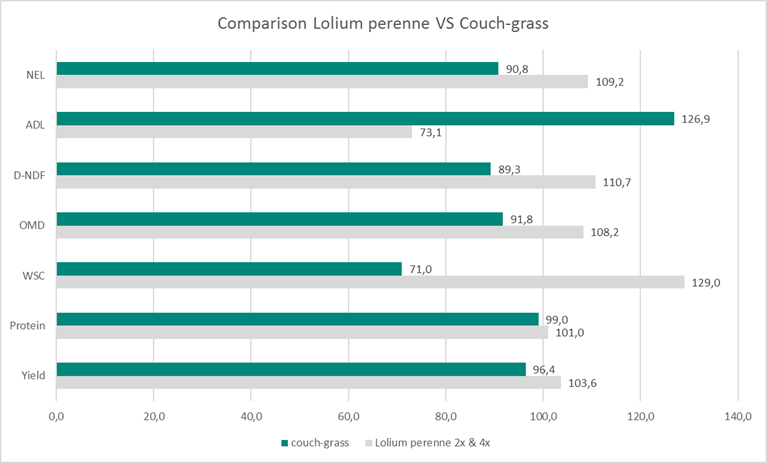
Should I renew my grassland? We all know the advices, at lower proportions of desirable grasses yearly overseeding is most of the time sufficient. But at higher proportions of non-desirable grasses or couch-grass spray, plough / restart the field is often the only solution. After a bit of calculation and internet search you can find the costs for renewal.
But what are the yields and forage quality levels of non-desirable grasses like for example couch-grass? Only when you know these data you know which potential yields and quality you are not achieving. Searching on the internet sometimes you can find some of these data but most of the time these are from older studies.
To get reliable up to date data and to give the farmer a suitable advice DSV drilled in several both desirable and non-desirable grasses in their forage innovation field to test the potentials.
In practice after some years you can see occurring spots with couch-grass, mainly at dryer fields. The underground root rhizomes are gaining more and more of the space in your field. Yield wise a lack in yield is most of the time not seen by the farmer. Based on the DSV data the yield difference between desirable grasses and couch-grass is about 15% and therefore indeed not really noticed in practice.
Even if the lack in yield is not severe, most of the farmers can agree that the cows would not really graze the couch-grass spots properly. After a grazing round most of this couch-grass will be trampled but not grazed. When you feel and touch couch-grass you will find out that the leaves are harder and a bit sharpe. This could be one of the reasons why cows are not happy to graze them.
Thanks to the DSV trial we got more inside information about the quality parameters of couch-grass. Compared with Lolium perenne the forage quality is really low. That cows will not happy graze it can be explained by relatively 60 % lower WSC (sugar) content and the 16 % lower digestibility. Relatively couch-grass consist of 50 % more ADL (lignin) which has a negative effect on digestibility and palatability.
Summarizing the forage quality as the NEL (Net Energy Lactation) the absolute value of couch-grass (5,1 NEL) is 1 NEL lower as Lolium perenne (6,1 NEL).
The advice to renew your grassland at higher proportions of couch-grass is a logic choice. Couch-grass lowers the forage quality resulting in lower milk productions. In addition it can spread aggressively in the field. So when you spot couch-grass, react on it!
